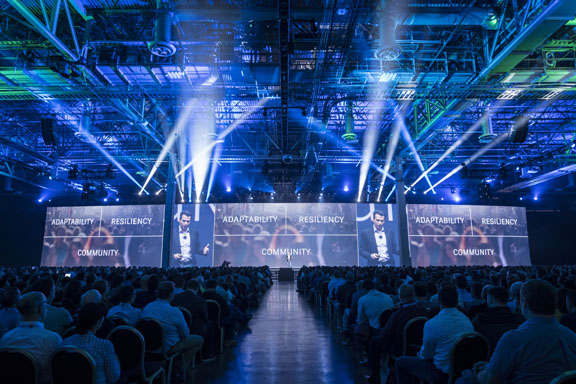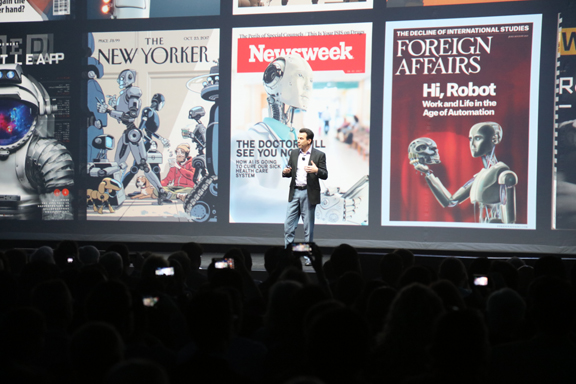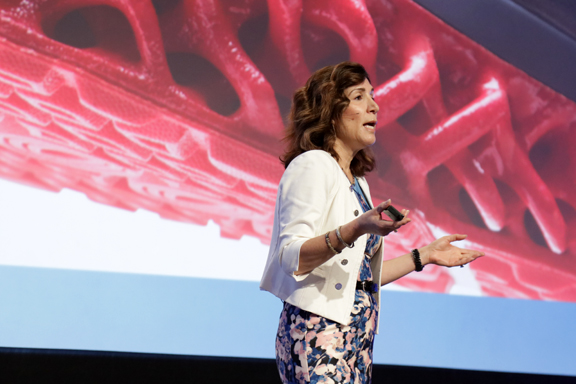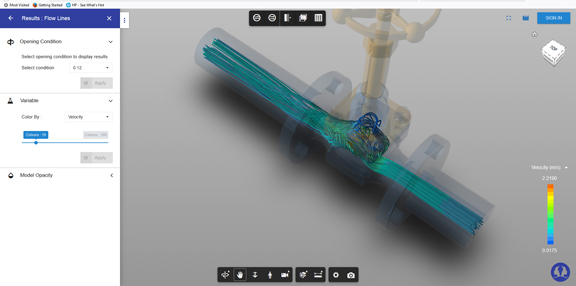AU 2017: Seeking Assurance in Times of AI and Automation

Autodesk CEO Andrew Anagnost took the stage at AU 2017 (image courtesy of Autodesk).
Latest News
November 22, 2017
 Autodesk CEO Andrew Anagnost took the stage at AU 2017 (image courtesy of Autodesk).
Autodesk CEO Andrew Anagnost took the stage at AU 2017 (image courtesy of Autodesk).Last week, as he stepped up to the stage in The Venetian’s ballroom to address the Autodesk faithfuls gathered at AU 2017, Andrew Anagnost tackled the anxiety that might be on most people’s mind.
“For the last three years, that’s all we’ve been talking about,” he reminded the audience. “We’ve been talking about the robot revolution, about numerous kinds of automation, new capabilities that are indisputably going to replace some of the things you do everyday. So what does it mean for your job? Are we moving to a world of driver-less cars, and driver-less CAD?”
Autodesk in the recent years have been building up its generative design muscles. Project Dreamcatcher, once an experimental technology in the research phase, exemplifies Autodesk’s generative design aspirations. Components of Dreamcatcher are now mature enough to be part of Autodesk’s core offerings such as Netfabb, with robust optimization tools for additive manufacturing projects.
Describing the principles behind generative design, Autodesk writes:
Designers or engineers input design goals into generative design software, along with parameters such as materials, manufacturing methods, and cost constraints. Then, using cloud computing, the software explores all the possible permutations of a solution, quickly generating design alternatives. It tests and learns from each iteration what works and what doesn’t.
Some might call it algorithm-driven design. Some might call it topology optimization. And some might justifiably call it AI-driven design. For many CAD veterans who had to devote a good portion of their life to master the complex CAD software user interfaces to be able to sculpt the desired geometric shape, generative design is the dawn of driver-less CAD.
“Or are we moving to a bright future? One where we can all make more, better, with less?,” asked Anagnost.
Even if inevitable future is bright, it signals fundamental changes in the design world—a world largely shaped by Autodesk and its major rivals.
 Is the rise of robotics and AI the end of your job? Anagnost tackled the question at AU 2017 (image courtesy of Autodesk).
Is the rise of robotics and AI the end of your job? Anagnost tackled the question at AU 2017 (image courtesy of Autodesk).The Sole of Algorithmic Aesthetics
In her keynote, Lisa Campbell, Autodesk’s market strategist and futurist for manufacturing, engineering, and construction, put her best foot forward, so to speak.
“[The sole of Autodesk client Under Armor‘s athletic shoes] has lattice work that’s so complicated not one of us could have designed and modeled this without generative design,” she pointed out. “It could not have been manufactured without advanced capabilities like 3D additive printing.”
Generative design, driven by computation, tends to result in the software recommending geometry that’s impossible or impractical to manufacture using traditional methods. Therefore, it creates new opportunities—and new challenges—for those seeking to exploit the emerging industrial 3D printing systems.
For more on Under Armor’s use of generative design and 3D printing, read the Autodesk blog post here.
 The complex sole of Under Armor shoes were the result of the convergence of generative design and 3D printing, according to Lisa Campell, Autodesk strategist and futurist (image courtesy of Autodesk).
The complex sole of Under Armor shoes were the result of the convergence of generative design and 3D printing, according to Lisa Campell, Autodesk strategist and futurist (image courtesy of Autodesk).A New Dor for Data-Driven Products
Traditional manufacturing processes were driven largely by the need to produce uniform products in large volumes, such as ready-to-wear shoes in different sizes to meet the diverse population’s need or standard TV sets that could be instantly put to use in the consumer’s living room.
But Steven Hooper, Autodesk’s director of manufacturing strategy, urges customers to look beyond the horizon of commodity products. Data-driven products with additional insights, he pointed out, is one way to rise above the crowd.
Autodesk client Dor markets its camera-equipped monitoring device as a “foot traffic solution” to retail store operators. What distinguishes Dor is neither the aesthetics of the device nor the function. Hooper would be the first to acknowledge Dor’s geometry is rather simple and straightforward—a slim, flat housing with a connected camera.
However, the data-driven insights it offers make the hardware much more than a camera for remote viewing. “They track people coming into the store, transmit that data into the cloud server, cross-reference it with things like weather, local sports activity, games going on in the surrounding area,” explained Hooper. “Using machine learning, they derive insights to help store owners get predictive insights on things that will likely impact the business.”
If Dor were to market the device as a piece of hardware, the company probably cannot charge much. Average webcams are about $30-$40.
Dor sells its monitoring system—complete with analytics and reports—for much more. $190 for the starter hardware kit, plus $44 per location per month and higher subscription fees.
On the fierce battlefront where manufacturers compete on better, faster, cheaper products, some doors may be closing. But new doors (or Dors) are also opening in the IoT era’s data-driven commerce.
Forged in App-Style Engineering
This year, the AU venue in Las Vegas also hosted Forge DevCon, which draws many application developers working with the Autodesk Forge platform. Among them is Sandip Jadhav, cofounder and CEO of Center of Computational Technologies, Pune, India.
Jadhav and his development team are behind SimulationHub, a web portal offering several app-style simulation solutions. Built on AWS infrastructure using OpenFOAM, SimulationHub relies on the Autodesk View and Data API, part of Autodesk Forge, to allow users to run template-style simulation jobs from mobile devices.
Recently, SimulationHub launched three of its apps as commercial releases: Control Valve Performer, Pedestrian Comfort Analysis, and Generic Simulation. The SaaS-style apps are priced $500 per month, or $5,000 per year.
SimulationHub is part of the movement to simplify simulation for design engineers by packaging it as template-driven applications, accessible from the cloud. Cloud-hosted simulation apps dramatically lower the barrier for entry for design experiments. They typically demand little or no software training, and they take on the IT burden—two hurdles usually associated with introducing general purpose simulation software to new users.
 SimulationHub, built on AWS, OpenForm, and Autodesk Forge APIs, allows you to run simulation from a browser (image courtesy of SimulationHub).
SimulationHub, built on AWS, OpenForm, and Autodesk Forge APIs, allows you to run simulation from a browser (image courtesy of SimulationHub).The Beginning of the Anagnost Era
For Andrew Anagost, AU 2017 marks a milestone. It’s his debut as the company’s CEO.
Earlier this year, Carl Bass, who had shepherded Autodesk since 2006, retired, prompting a new CEO search. In June, Anagnost officially stepped into the role.
Anagnost was among the company executives who championed the company’s transition from perpetual licensing to subscription licensing, arguably one of the riskiest moves Autodesk has made in its recent history.
Anagnost also believes the consumption-based model is the way of the future. This could be seen in the way the company now markets the Autodesk Forge development platform, based on the APIs accessed and the cloud credits used.
“Nobody out there starting a software company right now is thinking of perpetual licensing,” said Anagnost in his Q&A with the industry press at AU. “I also believe machine learning algorithms and highly compute intensive algorithms will turn most subscription companies into consumption companies. That’s inevitable.”
Under his reign, technologies like generative design could become consumption-based solutions, delivered from the cloud, priced per usage.
In his keynote, Hooper said, “[With generative design,] there isn’t just one right answer, but there are many viable alternatives. [Technology] doesn’t replace the design engineers; it augments them with the ability to explore that solution universe.”
In other words, generative design is not autonomous CAD or self-driving CAD. But many may find their jobs and required skill sets shift, from digital geometry sculpting to design exploration using simulation and algorithms.
Is it a bright future or a grim one? That depends on your attitude toward change and adaptation.
Subscribe to our FREE magazine, FREE email newsletters or both!
Latest News
About the Author
Kenneth Wong is Digital Engineering’s resident blogger and senior editor. Email him at [email protected] or share your thoughts on this article at digitaleng.news/facebook.
Follow DE





